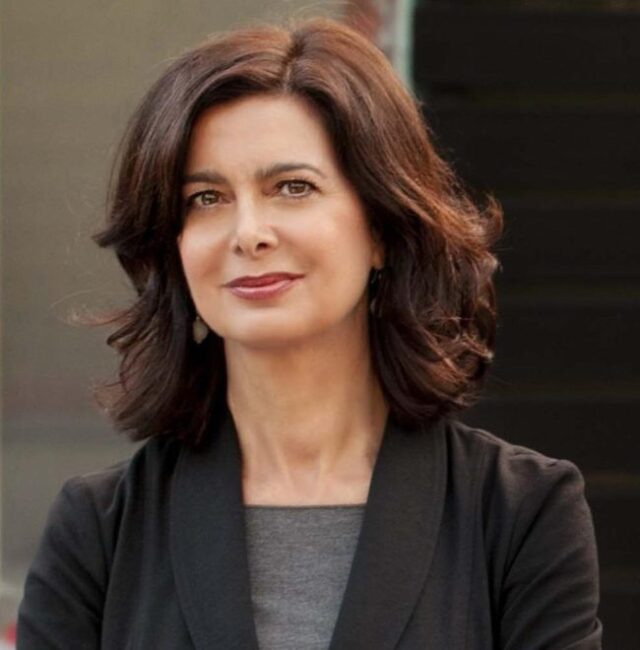Nel panorama artistico contemporaneo uno tra i denominatori comuni è la capacità, nonché necessità, di porsi in posizione di osservazione nei confronti della realtà, attuale, della società e soprattutto dell’interazione tra la moltitudine di individui le cui vite si intrecciano quasi inconsapevolmente e che delinea il modo di vivere della modernità. Alcuni artisti interpretano l’osservato sulla base delle proprie sensazioni, altri invece lasciano fuoriuscire in qualche modo un giudizio, un proprio punto di vista su ciò su cui lo sguardo si posa, mentre altri mostrano la capacità di descriverlo in maniera oggettiva, astraendosi così da ogni intenzione soggettiva, lasciando che siano le immagini narrate a raggiungere l’osservatore facendone vibrare le corde interiori sulla base della propria emotività. Il protagonista di oggi rappresenta una voce solista nel panorama artistico internazionale, sia per la sua tendenza a raccontare ciò che vede senza infondere nelle sue opere una propria visione che manipolerebbe in qualche modo il sentire dell’osservatore, sia per uno stile espressivo decisamente originale e in grado di conquistare proprio in virtù della sua indefinitezza.
Intorno alla metà dell’Ottocento nacque in Europa un movimento pittorico volto a mettere in evidenza la realtà senza alcun tipo di interpretazione da parte dell’esecutore dell’opera, piuttosto trasformando la pittura in un attento sguardo sulla vita quotidiana, mettendo per la prima volta in evidenza i gesti e le piccole abitudini delle persone umili, dei lavoratori, di coloro che di fatto abitavano nelle strade, che producevano ed erano al servizio delle persone più abbienti. Il Realismo dunque non si limitò a essere solo un esercizio estetico di riproduzione dell’osservato bensì divenne, seppur forse inconsapevolmente nelle intenzioni degli artisti, un importante documento della vita di quell’epoca in fase di trasformazione. Tra le immagini quasi poetiche di Gustave Courbet e i temi sociali che divennero un manifesto di ribellione della classe operaia contro lo sfruttamento dei ricchi possidenti terrieri delle opere di Diego Rivera e di Giuseppe Pellizza da Volpedo, il Realismo divenne pertanto un incredibile documento, simbolo di un’attenzione al sociale che fino a poco prima sembrava essere inesistente. Ma in quel fervente periodo storico ben presto l’attenzione artistica si spostò verso un Astrattismo estremo, con tutte le sottocorrenti che ne derivarono, perciò fu necessario attendere fino alla metà del Ventesimo secolo per tornare all’attenzione verso la realtà, alla riproduzione di ciò che lo sguardo osservava. Negli Stati Uniti degli anni Sessanta cominciò a emergere un movimento che si imponeva di raccontare oggettivamente tutto ciò che rappresentava il mondo moderno, le abitudini e il modo di vivere di una società che era profondamente cambiata, che aveva visto emergere una nuova classe media che stava acquistando sempre più potere di acquisto determinando le offerte commerciali; la nuova corrente pittorica, definita inizialmente Fotorealismo ma ben presto trasformatasi in Iperrealismo, mostrò la società dell’epoca, la vita metropolitana fatta di luce e di superfici riflettenti come nelle tele di Richard Estes, forse quello, tra tutti, a essere più interessato proprio alla moltitudine e al costante muoversi e vibrare delle città. Malgrado l’intento degli iperrealisti fosse la pura riproduzione oggettiva della realtà, di fatto le loro tele sono piene di riferimenti e di spunti di riflessione che non possono fare a meno di coinvolgere gli osservatori più sensibili sui cambiamenti che si sono susseguiti fino ai nostri giorni.
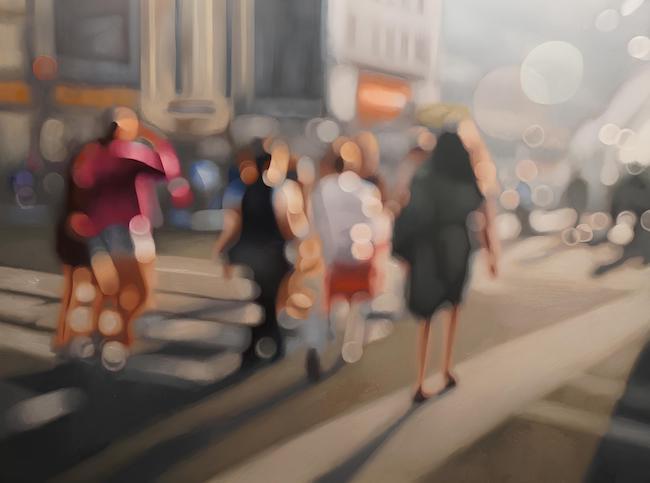
L’artista sudafricano Philip Barlow attinge alle linee guida del Realismo e dell’Iperrealismo per quel suo bisogno di osservare le persone, gli attimi di vita quotidiana che spesso sfuggono all’osservazione ma che invece rivestono un fascino particolare per questo originale artista, ma poi tende verso una sorta di Astrattismo, oltrepassa la perfezione dell’immagine per confonderla, per sfocare tutto ciò che resterebbe troppo esteticamente impeccabile trasformandolo così in un’infinita possibilità interpretativa, un caleidoscopio di punti di vista che si sovrappongono rifrangendo la luce e i dettagli i quali divengono pertanto indefiniti. Sembra essere un momento di passaggio verso l’astrazione il suo stile, pur rimanendo fortemente legato all’immagine, perché in fondo, sembra suggerire Barlow, non ci si può distaccare completamente dalla realtà che viene vissuta.
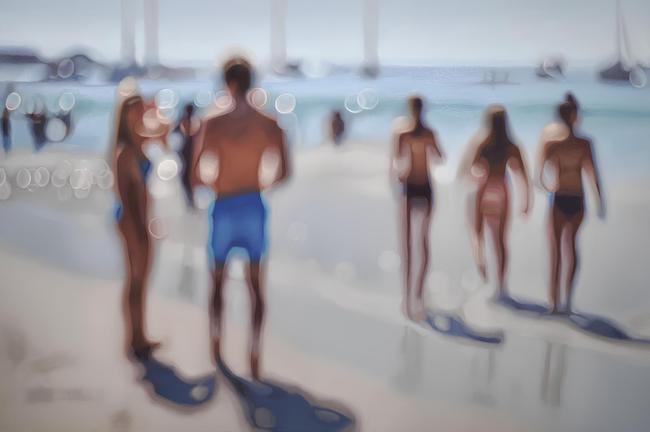
Del Fotorealismo prende la tecnica di base, quella cioè di immortalare con l’obiettivo della sua macchina fotografica frammenti e scene che colpiscono la sua attenzione, che lo incuriosiscono proprio perché vanno a porre l’accento sugli scorci di quotidianità delle persone, o sulla vita caotica delle città, o ancora sui panorami notturni dove le luci divengono di fatto prime attrici di un mondo affascinante e intimo; la padronanza della tecnica fotografica gli consente di effettuare quelle sfocature che poi vengono riprodotte sulla tela e arricchite con una tavolozza cromatica vivace, intensa, in cui ciò che si evidenzia è l’atmosfera generale.
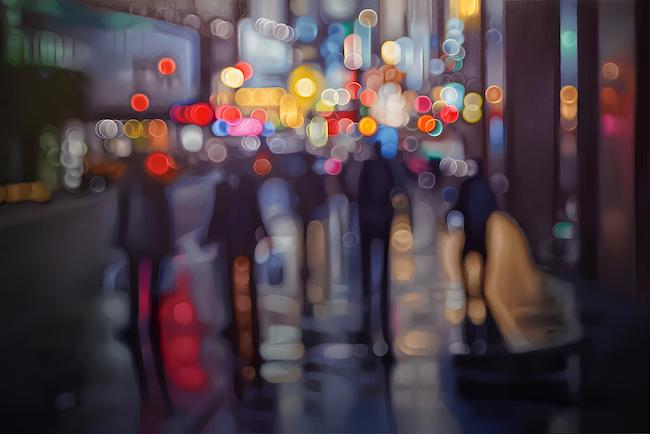
Ma ad affascinare Philip Barlow è la moltitudine, quella folla che va a generare l’esistenza quotidiana, quei tanti che ogni giorno vivono all’interno della propria individualità dimenticando di essere parte di un enorme gruppo, quello della civiltà umana che esattamente in virtù dell’incontrarsi, confrontarsi, sostenersi o contrastarsi, dà luogo all’inevitabile evoluzione a cui in ogni secolo si è stati sottoposti.
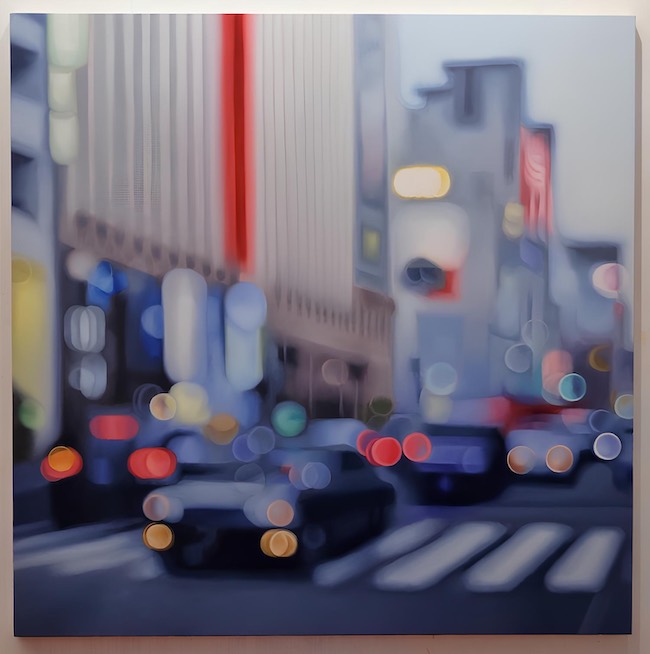
La sua osservazione è diversa da quella del Realismo di metà Ottocento, non vi è più la lotta per i propri diritti, la necessità di denunciare le ingiustizie sociali che avevano bisogno di venire alla luce e trovare una risoluzione, bensì il desiderio di raccontare scorci di quotidianità che solo nel momento presente vengono vissuti con nitidezza ma un attimo dopo il ricordo sbiadisce lasciano che siano le sensazioni provate a emergere e sopravvivere al passaggio veloce degli eventi. È questo il motivo di quell’indefinitezza nella riproduzione del visibile, perché in fondo ciò che resta è l’impressione complessiva, il senso del tutto che esce dall’individualità del singolo e diviene visione più ampia, meno definita ma non per questo meno affascinante o coinvolgente. Le spiagge, la vita nelle metropoli e le notti nelle città sono i luoghi preferiti da Philip Barlow per catturare quei frammenti di vita che diventano protagonisti delle sue tele, grandi, enormi, come se fossero finestre sul mondo che egli stesso ha scelto di riprodurre e poi di rendere vago, nebuloso, indistinguibile.
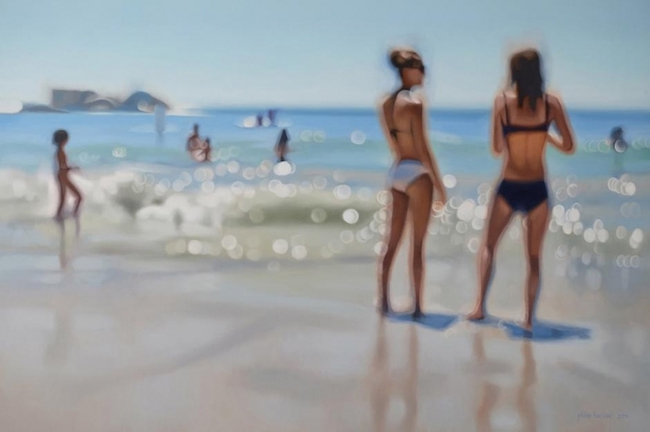
In Soak l’artista descrive un momento estivo, persone sulla riva che si lasciano accarezzare dal sole, in un frangente di esistenza che appartiene alla memoria collettiva di tutti e così lo rende indistinto, vago, perché in fondo non importa chi siano le ragazze in primo piano, non importa come si chiamino o di cosa stiano parlando. Ciò che conta è la percezione di serenità, del lento scorrere del tempo che contraddistingue le giornate in spiaggia, in quella morbidezza di atteggiamento che non si lega alla velocità dei ritmi cittadini, e dunque tutto appare sfuocato, immerso però nella luminosità dei raggi del sole e del chiarore dell’acqua. Si ha la sensazione di sentire il vocio delle persone sulla spiaggia e le grida indistinte dei bambini che giocano con l’acqua osservando questo dipinto.
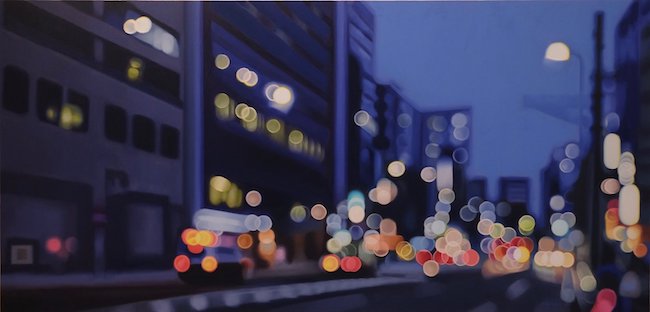
Nella tela Leaving Shibuya invece emerge tutta l’attrazione che Philip Barlow sente nei confronti delle metropoli, di quei mondi caotici e pieni di traffico che però non possono fare a meno di esercitare una malìa su qualsiasi osservatore; le notti urbane si accendono grazie ai fari delle auto, alle luci dei lampioni, alle insegne, e catturano lo sguardo perché dipingono un universo fatto di rumori ma anche di suggestione, di quello scintillio che da sempre appartiene alla notte nelle città. L’indefinitezza dei soggetti contribuisce ad accrescere il fascino della composizione, così come l’armonia tra colori e forme appena accennate che ne sottolineano l’amalgama percettivo dello sguardo.
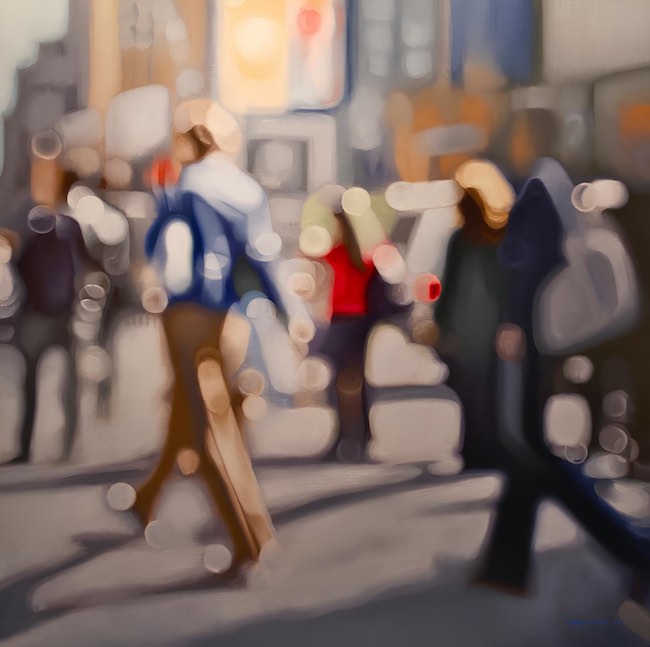
E ancora in Waiting on Time Square, Barlow racconta ancora una volta la folla, le persone, tutte quelle individualità che intrecciano le proprie esistenze quotidianamente senza notarsi, senza mai guardarsi negli occhi, e questo se da un lato può sembrare alienante dall’altro, suggerisce l’artista, può permettere a ciascuno di essere se stesso, senza timore del giudizio, senza preoccuparsi di dover sembrare diversi da come si è bensì essendo semplicemente una parte di quella folla, di quel via vai continuo di persone che generano la vita contemporanea. Le osservazioni di Philip Barlow inducono alla riflessione, al desiderio di lasciarsi trasportare dalle sensazioni di positività e armonia che fuoriescono dalla gamma cromatica vivace e luminosa e da quell’indistinto che costituisce il tratto caratteristico di questo originale artista. Philip Barlow ha al suo attivo mostre personali e collettive in Sud Africa, Stati Uniti, Inghilterra, Olanda, Grecia, Singapore e Canada e le sue opere sono rappresentate da Everard Read di Cape Town e di Londra, da Galerie LeRoyer di Montréal e Toronto e dalla Bugno Art Gallery di Venezia.
PHILIP BARLOW-CONTATTI
Email: studio@philipbarlow.com
Sito web: https://www.philipbarlow.com/
Facebook: https://www.facebook.com/philip.barlow.395
Instagram: https://www.instagram.com/philipbarlow/
Philip Barlow’s blurred visions, between chromatic intensity and the fascination of everyday life
In the contemporary art scene, one of the common denominators is the ability, as well as the need, to place oneself in a position of observation with regard to reality, today’s society and, above all, the interaction between the multitude of individuals whose lives are intertwined almost unconsciously and who outline the way of life of modernity. Some artists interpret the observed on the basis of their own sensations, while others somehow let out a judgement, their own point of view on what they are looking at, and others show the ability to describe it objectively, abstracting themselves from all subjective intentions, letting the narrated images reach the observer, making their inner chords vibrate on the basis of their own emotionality. Today’s protagonist represents a solo voice on the international art scene, both because of his tendency to narrate what he sees without infusing his artworks with his own vision that would somehow manipulate the observer’s feeling, and because of a decidedly original expressive style that is able to conquer precisely because of its indefiniteness.
Around the middle of the 19th century, emerged in Europe a pictorial movement emerged aimed at highlighting reality without any kind of interpretation on the part of the executor of the work, rather transforming painting into a close look at everyday life, underlining for the first time the gestures and small habits of humble people, of workers, of those who actually lived on the streets, who produced and were at the service of the better-off. Realism therefore did not limit itself to being merely an aesthetic exercise of reproducing the observed, but became, albeit perhaps unconsciously in the artists’ intentions, an important document of the life of that changing era. Between the almost poetic images of Gustave Courbet and the social themes that became a manifesto of working class rebellion against the exploitation of the wealthy landowners in the paintings of Diego Rivera and Giuseppe Pellizza da Volpedo, Realism thus became an incredible document, a symbol of a focus on the social that until recently had seemed to be non-existent.
But in that fervent historical period, artistic attention soon shifted towards an extreme Abstractionism, with all the undercurrents that came with it, so it was necessary to wait until the middle of the 20th century to return to a focus on reality, on the reproduction of what the eye observed. In the United States of the 1960s saw the emergence of a movement that set out to objectively portray everything that represented the modern world, the habits and way of life of a society that had profoundly changed, which had seen the emergence of a new middle class that was gaining more and more purchasing power by determining commercial offers; the new pictorial current, initially defined as Photorealism but soon transformed into Hyperrealism, showed the society of the time, the metropolitan life made of light and reflecting surfaces as in the paintings of Richard Estes, perhaps the one, among all, who was most interested in the multitude and the constant moving and vibrating of cities. Although the intention of the hyperrealists was the pure objective reproduction of reality, in fact their canvases are full of references and food for thought that cannot help but involve the most sensitive observers of the changes that have taken place up to the present day. The South African artist Philip Barlow draws on the guidelines of Realism and Hyperrealism for his need to observe people, the moments of everyday life that often escape observation but which instead hold a particular fascination for this original artist, but then goes he goes beyond the perfection of the image to muddle it, to blur everything that would remain too aesthetically impeccable thus transforming it into an infinite possibility of interpretation, a kaleidoscope of points of view that overlap, refracting light and details that thus become undefined. His style seems to be a moment of transition towards Abstractionism, while remaining strongly tied to the image, because after all, Barlow seems to suggest, one cannot completely detach oneself from the reality that is experienced. From Photorealism he takes the basic technique, that is that of immortalising with the lens of his camera fragments and scenes that strike his attention, that intrigue him precisely because they emphasise glimpses of people’s everyday life, or the chaotic life of cities, or even night scenes where the lights become the main actors of a fascinating and intimate world; his mastery of photographic technique enables him to make those blurs that are then reproduced on canvas and enriched with a lively, intense colour palette in which what stands out is the overall atmosphere. But what fascinates Philip Barlow is the multitude, that crowd that goes to generate everyday existence, those many who every day live within their own individuality, forgetting that they are part of an enormous group, that of human civilisation, which precisely by virtue of meeting, confronting, supporting or opposing each other, gives rise to the inevitable evolution to which we have been subjected in every century.
His observation is different from that of mid-nineteenth-century Realism, there is no longer the struggle for one’s rights, the need to denounce social injustices that needed to come to light and find a resolution, but rather the desire to recount glimpses of daily life that only in the present moment are experienced with clarity but a moment later the memory fades, allowing the sensations felt to emerge and survive the rapid passage of events. This is the reason for that indefiniteness in the reproduction of the visible, because in the end what remains is the overall impression, the sense of the whole that emerges from the individuality of the single one and becomes a broader vision, less defined but no less fascinating or involving. Beaches, life in metropolises and city nights are Philip Barlow‘s favourite places to capture those fragments of life that become the protagonists of his canvases, large, enormous, as if they were windows on the world that he himself has chosen to reproduce and then to make vague, nebulous, indistinguishable. In Soak, the artist describes a summer moment, people on the shore being caressed by the sun, in a moment of existence that belongs to everyone’s collective memory and so he makes it indistinct, vague, because in the end it does not matter who the girls in the foreground are, it does not matter what their names are or what they are talking about. What is important is the perception of serenity, of the slow passage of time that characterises days at the beach, in that softness of attitude that is not tied to the speed of city rhythms, and therefore everything appears blurred, yet bathed in the brightness of the sun’s rays and the glow of the water. One has the sensation of hearing the hubbub of people on the beach and the indistinct cries of children playing in the water while observing this painting.
In the canvas Leaving Shibuya, on the other hand, Philip Barlow‘s attraction to the metropolis emerges, to those chaotic, traffic-filled worlds that cannot help but exert a curse on any observer; urban nights are lit up by car headlights, street lamps and signs, and capture the gaze because they paint a universe made up of noise but also of suggestion, of that sparkle that has always belonged to the night in cities. The indefiniteness of the subjects contributes to the fascination of the composition, as does the harmony between colours and barely noticeable shapes that emphasise the perceptive amalgam of the gaze. And in Waiting on Time Square, Barlow once again depicts the crowd, the people, all those individualities who intertwine their existences on a daily basis without noticing each other, without ever looking into each other’s eyes, and while this may seem alienating, the artist suggests that it can allow one to be oneself, without fear of judgement, without worrying about having to look different from one’s self, but simply being a part of that crowd, that constant coming and going of people that generate contemporary life. Philip Barlow‘s observations induce reflection, a desire to be carried away by the feelings of positivity and harmony that emanate from the lively, luminous colour palette and the indistinctness that is the hallmark of this original artist. Philip Barlow has solo and group exhibitions in South Africa, the United States, England, Holland, Greece, Singapore and Canada to his credit and his works are represented by Everard Read in Cape Town and London, Galerie LeRoyer in Montreal and Toronto and the Bugno Art Gallery in Venice.











